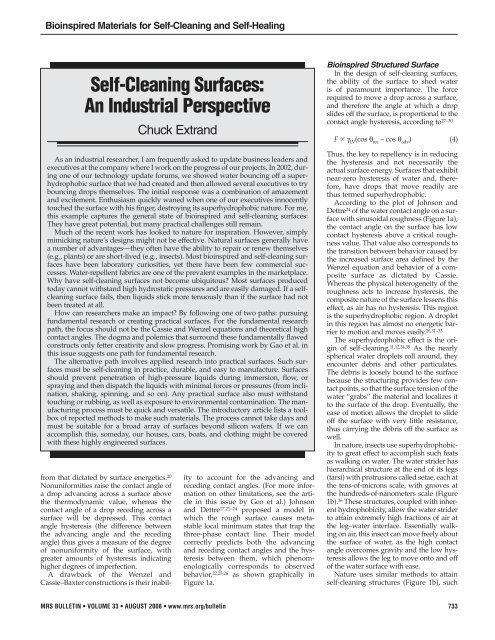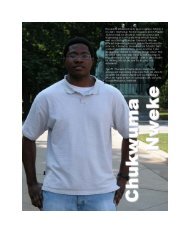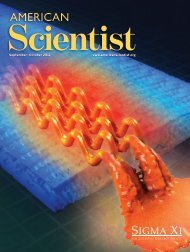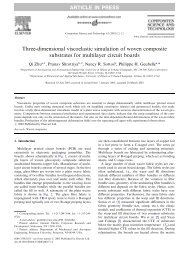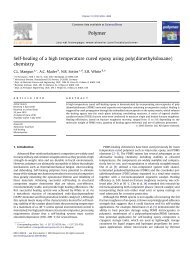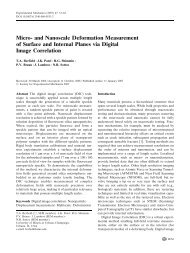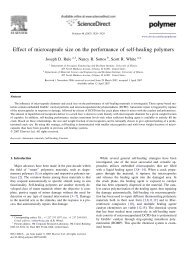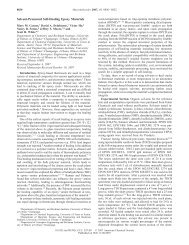Bioinspired Materials for Self-Cleaning and Self-Healing - Sottos ...
Bioinspired Materials for Self-Cleaning and Self-Healing - Sottos ...
Bioinspired Materials for Self-Cleaning and Self-Healing - Sottos ...
- No tags were found...
Create successful ePaper yourself
Turn your PDF publications into a flip-book with our unique Google optimized e-Paper software.
<strong>Bioinspired</strong> <strong>Materials</strong> <strong>for</strong> <strong>Self</strong>-<strong>Cleaning</strong> <strong>and</strong> <strong>Self</strong>-<strong>Healing</strong><strong>Self</strong>-<strong>Cleaning</strong> Surfaces:An Industrial PerspectiveChuck Extr<strong>and</strong>As an industrial researcher, I am frequently asked to update business leaders <strong>and</strong>executives at the company where I work on the progress of our projects. In 2002, duringone of our technology update <strong>for</strong>ums, we showed water bouncing off a superhydrophobicsurface that we had created <strong>and</strong> then allowed several executives to trybouncing drops themselves. The initial response was a combination of amazement<strong>and</strong> excitement. Enthusiasm quickly waned when one of our executives innocentlytouched the surface with his finger, destroying its superhydrophobic nature. For me,this example captures the general state of bioinspired <strong>and</strong> self-cleaning surfaces:They have great potential, but many practical challenges still remain.Much of the recent work has looked to nature <strong>for</strong> inspiration. However, simplymimicking nature’s designs might not be effective. Natural surfaces generally havea number of advantages—they often have the ability to repair or renew themselves(e.g., plants) or are short-lived (e.g., insects). Most bioinspired <strong>and</strong> self-cleaning surfaceshave been laboratory curiosities, yet there have been few commercial successes.Water-repellent fabrics are one of the prevalent examples in the marketplace.Why have self-cleaning surfaces not become ubiquitous? Most surfaces producedtoday cannot withst<strong>and</strong> high hydrostatic pressures <strong>and</strong> are easily damaged. If a selfcleaningsurface fails, then liquids stick more tenuously than if the surface had notbeen treated at all.How can researchers make an impact? By following one of two paths: pursuingfundamental research or creating practical surfaces. For the fundamental researchpath, the focus should not be the Cassie <strong>and</strong> Wenzel equations <strong>and</strong> theoretical highcontact angles. The dogma <strong>and</strong> polemics that surround these fundamentally flawedconstructs only fetter creativity <strong>and</strong> slow progress. Promising work by Gao et al. inthis issue suggests one path <strong>for</strong> fundamental research.The alternative path involves applied research into practical surfaces. Such surfacesmust be self-cleaning in practice, durable, <strong>and</strong> easy to manufacture. Surfacesshould prevent penetration of high-pressure liquids during immersion, flow, orspraying <strong>and</strong> then dispatch the liquids with minimal <strong>for</strong>ces or pressures (from inclination,shaking, spinning, <strong>and</strong> so on). Any practical surface also must withst<strong>and</strong>touching or rubbing, as well as exposure to environmental contamination. The manufacturingprocess must be quick <strong>and</strong> versatile. The introductory article lists a toolboxof reported methods to make such materials. The process cannot take days <strong>and</strong>must be suitable <strong>for</strong> a broad array of surfaces beyond silicon wafers. If we canaccomplish this, someday, our houses, cars, boats, <strong>and</strong> clothing might be coveredwith these highly engineered surfaces.from that dictated by surface energetics. 20Nonuni<strong>for</strong>mities raise the contact angle ofa drop advancing across a surface abovethe thermodynamic value, whereas thecontact angle of a drop receding across asurface will be depressed. This contactangle hysteresis (the difference betweenthe advancing angle <strong>and</strong> the recedingangle) thus gives a measure of the degreeof nonuni<strong>for</strong>mity of the surface, withgreater amounts of hysteresis indicatinghigher degrees of imperfection.A drawback of the Wenzel <strong>and</strong>Cassie–Baxter constructions is their inabilityto account <strong>for</strong> the advancing <strong>and</strong>receding contact angles. (For more in<strong>for</strong>mationon other limitations, see the articlein this issue by Geo et al.) Johnson<strong>and</strong> Dettre 17,21–24 proposed a model inwhich the rough surface causes meta -stable local minimum states that trap thethree-phase contact line. Their modelcorrectly predicts both the advancing<strong>and</strong> receding contact angles <strong>and</strong> the hysteresisbetween them, which phenom -enologically corresponds to observedbehavior, 22,25,26 as shown graphically inFigure 1a.<strong>Bioinspired</strong> Structured SurfaceIn the design of self-cleaning surfaces,the ability of the surface to shed wateris of paramount importance. The <strong>for</strong>cerequired to move a drop across a surface,<strong>and</strong> there<strong>for</strong>e the angle at which a dropslides off the surface, is proportional to thecontact angle hysteresis, according to 27–30F γ LV(cos θ rec– cos θ adv) (4)Thus, the key to repellency is in reducingthe hysteresis <strong>and</strong> not necessarily theactual surface energy. Surfaces that exhibitnear-zero hysteresis of water <strong>and</strong>, there<strong>for</strong>e,have drops that move readily arethus termed superhydrophobic.According to the plot of Johnson <strong>and</strong>Dettre 24 of the water contact angle on a surfacewith sinusoidal roughness (Figure 1a),the contact angle on the surface has lowcontact hysteresis above a critical roughnessvalue. That value also corresponds tothe transition between behavior caused bythe increased surface area defined by theWenzel equation <strong>and</strong> behavior of a compositesurface as dictated by Cassie.Whereas the physical heterogeneity of theroughness acts to increase hysteresis, thecomposite nature of the surface lessens thiseffect, as air has no hysteresis. This regionis the superhydrophobic region. A dropletin this region has almost no energetic barrierto motion <strong>and</strong> moves easily. 26,31–33The superhydrophobic effect is the originof self-cleaning. 11,12,34,35 As the nearlyspherical water droplets roll around, theyencounter debris <strong>and</strong> other particulates.The debris is loosely bound to the surfacebecause the structuring provides few contactpoints, so that the surface tension of thewater “grabs” the material <strong>and</strong> localizes itto the surface of the drop. Eventually, theease of motion allows the droplet to slideoff the surface with very little resistance,thus carrying the debris off the surface aswell.In nature, insects use superhydrophobicityto great effect to accomplish such featsas walking on water. The water strider hashierarchical structure at the end of its legs(tarsi) with protrusions called setae, each atthe tens-of-microns scale, with grooves atthe hundreds-of-nanometers scale (Figure1b). 36 These structures, coupled with inherenthydrophobicity, allow the water striderto attain extremely high fractions of air atthe leg–water interface. Essentially walkingon air, this insect can move freely aboutthe surface of water, as the high contactangle overcomes gravity <strong>and</strong> the low hysteresisallows the leg to move onto <strong>and</strong> offof the water surface with ease.Nature uses similar methods to attainself-cleaning structures (Figure 1b), suchMRS BULLETIN • VOLUME 33 • AUGUST 2008 • www.mrs.org/bulletin 733


